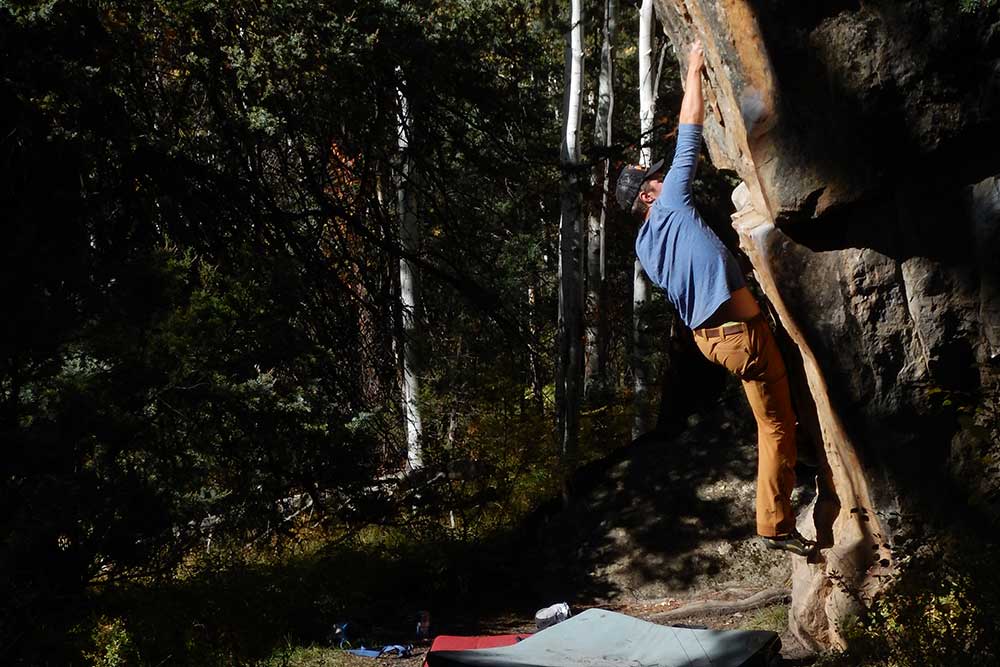Pull-Up Power! – The Road to Your First Pull-Up

By Hank Shell
Real talk: I tend to get ahead of myself when writing these articles. Whether it’s climbing the deserts of Utah or bouldering in the mountains of southwest Colorado, I just get so plum excited to share these experiences with you all that, occasionally, I forget all about the fundamentals. Most of these activities require a base level of fitness. In other words, you’ve got to put in a few hours at the gym before you can safely attempt them outside.
Case in point – climbing. Now, while I’m sure there are a few good climbers out there who rely exclusively on finesse, scorning strength for hitherto unknown powers of levitation, for the rest of us, there’s no getting around that initial strength training routine. And at the very heart of that routine lays one big, fat monster of an exercise – the pull-up. To the neophyte, the pull-up can seem like a more-than-insurmountable obstacle. So, let me cut to the chase. Today, we’re going to talk about the pull-up – the bane of high school fitness assessments everywhere.
Your First Pull-Up
Whether you’ve never even attempted a pull-up or are well on your way to completing that first repetition, I hope you’ll be able to glean something useful from this article.
To tell you the truth, when I first started climbing, I couldn’t do a pull-up. Embarrassing, I know. Well, not really. Lots of people can’t do pull-ups, and that’s nothing to be ashamed of. I mean, how often does one really need to do a pull-up in this day and age? You don’t need to claw your way to the top of a tall tree to get a McCafe. And so what about the crystal ware on that top shelf? You’ve got a stepping stool in the pantry. But, how about getting to the top of a sheer granite face? Yea. Pull-ups do that. And while we may not necessarily need to climb a mountain, we still do. Why? Because … well, just because. Because it’s exhilarating. Nay, rapturous. Because it fills us with a sense of accomplishment. Hell, because it’s there.
The Nature of Pull-Ups
So, what exactly is a pull-up? Well, if you were expecting me to wax philosophic on the act of pulling oneself upward, you’ve come to the wrong place. A pull-up is a pull-up is a pull-up. Let’s assume you’ve got a pull-up bar. If not, you’ll need to find one somewhere. Try, I don’t know, a gym? A playground? Even well manicured tree will work. With the bar, or limb, somewhere in the vicinity of your noggin, place your hands, palms facing forward, onto the bar, and, well, pull up. The chin-up, a variation in which the palms face your face, is essentially the same.
Ok, first things first. Pull-ups require muscles. Obviously. But not just our arms. In fact, muscles from the arms, shoulders, chest and back are all recruited when we do a pull-up, so bicep curls alone aren’t going to get our chin up to the bar. To get to that first pull-up, we’re going to break it down into a few muscle groups first. We’ll target them individually and then all at once, thus building up a solid foundation for our pull-up. First off, most of the power we generate during a pull-up comes from the upper back, and, more specifically, the latissimus dorsi, or lats for short.
The lats are those big strips of muscle on the upper flanks of the back. On a body builder, they’re the muscles that give the back its upside-down triangle shape. So, it follows that we’ll want to strengthen the lats to perform a pull-up. The best way to do this is with a weight-lifting exercise – the lat pull-down. In a gym, we do these exercises on a cable tower. You know, those menacing hunks of metal covered in pulleys and cables.
 These towers have a number of handle-like attachments. We’ll want to find the widest one and affix it to the top of the machine, so that we may pull it down. Yes, you read that right. To pull up, we must first pull down. Set the weight on the machine, usually with a lynchpin, to something manageable. Try twenty-five percent of your body weight. With the handle attached to the top of the tower, grab hold and sit down. Most of these machines have a dedicated seat, but if yours doesn’t, sit on the ground.
These towers have a number of handle-like attachments. We’ll want to find the widest one and affix it to the top of the machine, so that we may pull it down. Yes, you read that right. To pull up, we must first pull down. Set the weight on the machine, usually with a lynchpin, to something manageable. Try twenty-five percent of your body weight. With the handle attached to the top of the tower, grab hold and sit down. Most of these machines have a dedicated seat, but if yours doesn’t, sit on the ground.
Then, with your chin up and back straight, pull the bar down until it touches your chest. Be deliberate and controlled. Try doing three sets of eight to twelve repetitions. Start out doing this a couple of times a week. As you progress, bump it up to three, and continue to add weight, albeit in manageable increments.
You’ll probably find that after doing this workout, your biceps will also be sore. That’s because the exercise recruits the arms as well. It’s sort of a pre-pull up panacea, if you will.
Those Other Muscles
So, with the back squared away for now, we’ll get on to the arms. The biceps brachii are another big part of the pull-up. Luckily, there are ways to tackle these muscles with the torture tower from our last exercise! Everything is essentially the same, except we’ll find a narrower bar to tug on. Narrow enough that, when you’re holding onto the bar, it looks like you’ve been caught in an old fashioned stick up. Hands in the air! Again, you’ll pull the bar down to your chest. Do the exercise with your palms facing away from you and then again with them facing toward you. Follow the same recommendations for weight and repetitions.
Moving on, we’re going to want to think about the chest, shoulders and core. Shoulder mobility is crucial to pulling off a pull-up, so we want them good and strong. If you have major shoulder problems, you’ll want to talk to a physician to see if it’s safe for you to do a pull-up. So, how do we target the chest, shoulders and core? Why, all at once, of course! Brace yourself for another quasi-tautology. To pull up, we’re going to push up! Yes, push-ups target our chest and shoulders, while the plank-like position demands that we engage our core. If you’re not very good a push-ups, start with the on-your-knees version. Work your way up, starting wherever you feel comfortable.
Now, push-ups alone aren’t going to save our shoulders, so we’ll add something else to the mix. Dumbbell shrugs are easy, simple, and will help get those shoulders strong. Just grab a couple of dumbbells, stand in front of a mirror, make a silly face and shrug. Yep, just lift you shoulders up like you really couldn’t care less. Start with a comfortable weight and do about twenty-five repetitions. Increase weight and reps as needed.
Related Article: Get in Shape for Backcountry
On the Bar
Now that we’ve got our training routine underway, it’s time to get familiar with the pull-up bar. Hand strength is pretty important, too. I mean, we have to be able to hold onto the bar long enough to do a pull-up, right? Right. So, here’s what we’re going to do. Just hang. I know, it sounds boring. Just hanging there. Hanging out. Yep, it can be boring. Try occupying your mind with something constructive.
Recite a few lines of poetry from memory. Count as many prime numbers as you can. Compose that letter to so-and-so that you’ve been putting off – anything to keep your mind off that burning sensation creeping into your forearms. Don’t get me wrong – the pain is good. Still, you’ll be doing yourself a favor by ignoring it. Get on the pull-up bar every other day and hang for five to ten sets of 15 seconds or more. Finish these sessions off with a hang until failure. If you’ve done it right, your forearms will ache and your hands will be cramped into lifeless claws. It may sound gruesome, but hey, how bad do you want that pull-up? Another thing to keep in mind – while you’re hanging there, keep those shoulders engaged. You should feel your upper back scrunch together. It’ll keep your shoulders stable and prevent injury.
Now that we’ve got the real basic stuff out of the way, we’re going to get started on the pull-up itself. For this part, you’ll need a chair, a stool, or even a friend! All will work, though the stool and chair won’t rummage through your fridge or track mud through the house. The choice is yours. Place the stool or chair under the pull-up bar and place one foot on top. Use the foot as a support, weighting it just enough that you can complete the full pull-up motion five to ten times. If you’ve decided to go with a friend, have them hold onto your legs, giving you enough support to complete the motion. Do three to five sets. Remember to keep your core and shoulders engaged.
OK! You’re well on your way to that first pull-up! Just remember, don’t give up. As with all good things in life, doing a pull-up takes time and a little perseverance. But that sweet sensation of levitation when you finally do get your chin over the bar? That, ladies and gentleman, will be well worth the effort.
(adsbygoogle = window.adsbygoogle || []).push({});
You Might Like:
Increase the Intensity with HyperWear’s Vest Pro
Hank Shell Spring has arrived here in the beautiful San Juan Mountains. Those slate gray and gelid winter mornings are giving way, albeit reluctantly, to temperate sunrises and birdsong. Each day the rivers grow with...Muse: A heart rate monitor for your head
A Review by Hank Shell I’m all about mindfulness, y’all. If you’ve read my columns, you know this. If you haven’t, then that’s your misfortune. Anyway, mindfulness can have all kinds of wonderful health benefits,...Motiv Ring: The Next Best Innovative Fitness Tracker
Hank Shell There’s a piece of your workout kit that’s missing. Can you guess what it is? I’ll give you a hint – it’s not a steezy headband … or a shake weight. C’mon, dude....Pedaling Innovations: High-Performing & Comfortable Clipless Pedals
Hank Shell Everyone remembers the first time they ate it on a set of clip in pedals. I remember my first time like it was yesterday. It was crisp November morning at the RAT near...HIIT Hill Workouts For Runners
Hank Shell So, it’s winter time. And don’t get me wrong – I LOVE winter. I like skiing, throwing ice at passing cars and, more recently, climbing ice – see Cold ~ Hard ~ Ice...Cold ~ Hard ~ Ice Climbing in the San Juans
Hank Shell The sound of tearing fabric reached my ear, as it always does, with the delicacy of a lover’s whisper. It was an unintelligible anomaly, mired as it was in the din of the...(adsbygoogle = window.adsbygoogle || []).push({});
















